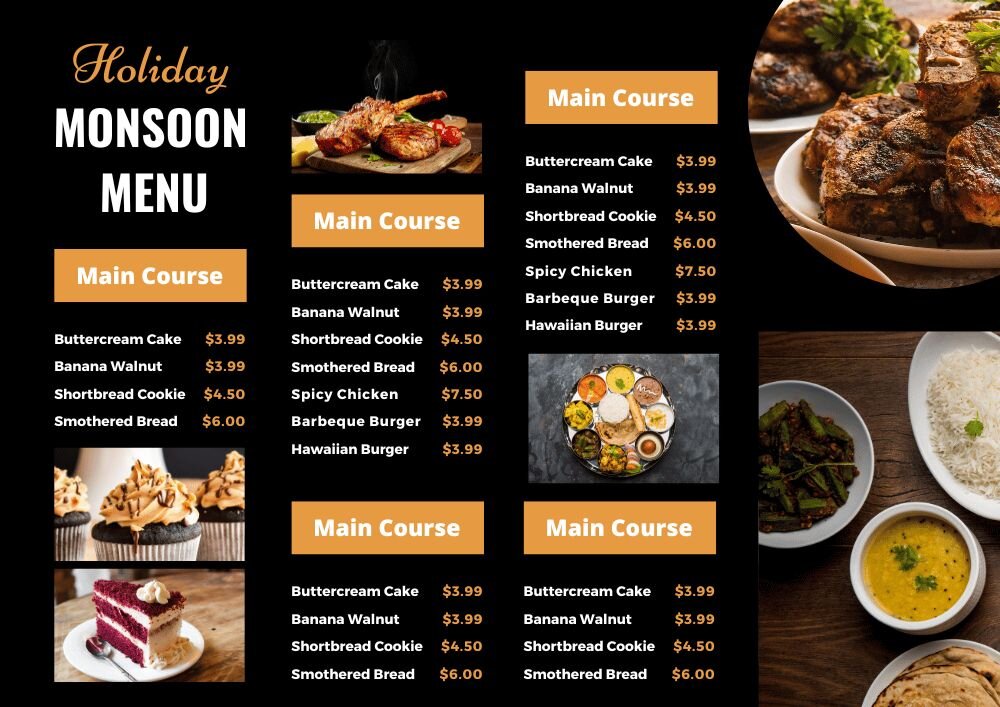In the ever-evolving world of hospitality, restaurant owners constantly seek ways to enhance customer experience and increase revenue. One of the most powerful, yet often overlooked, tools in the arsenal of restaurant marketing is the strategic use of food photography within restaurant menu design. A well-crafted image has the power to entice, inform, and persuade, often far more effectively than words alone. However, the use of food imagery in menus must be carefully considered—overuse or poor quality can have the opposite effect.
This article explores the when and how of integrating food photography into your restaurant menu design to maximize appeal and sales while maintaining brand integrity and a professional aesthetic.
The Psychology Behind Food Photography in Menus
Before delving into the design elements, it’s crucial to understand the psychological impact of food imagery. Visual stimuli play a critical role in the dining experience. Diners often “eat with their eyes” first, and seeing a delectable image of a menu item can trigger hunger, cravings, and emotional connections. This emotional response is key in guiding customer decisions.
Photos can reduce menu anxiety, which occurs when customers feel overwhelmed by too many choices or unfamiliar dishes. An image offers a quick reference, helping diners make confident selections, especially in multicultural or tourist-heavy areas where language might be a barrier.
When to Use Food Photography in Your Menu
While tempting, not every menu needs images. Knowing when to use food photography is as important as how.
1. Fast-Casual and Quick-Service Restaurants
These types of restaurants often benefit the most from using food images. Their customers typically make decisions quickly and rely on visual cues. Highlighting bestsellers or combo meals with appealing photographs can speed up decision-making and boost upselling opportunities.
2. Diverse or International Menus
If your menu includes unfamiliar cuisines or dishes, images can help bridge cultural gaps. For example, diners new to Thai, Ethiopian, or Japanese cuisine may feel more confident ordering when they can see the dish.
3. Specials and Seasonal Items
Featuring images of new or seasonal menu items is a great way to generate interest. Visuals create excitement and curiosity, prompting customers to try something outside their usual choices.
4. High-Profit Margin Items
Use imagery strategically to highlight items with the highest profit margins. A mouth-watering photograph can subtly nudge guests toward these selections, increasing overall profitability without appearing pushy.
5. Online and Digital Menus
With the rise of online ordering and QR code-based digital menus, photography plays an even more critical role. Without a server to describe items, a well-composed image can fill the gap, guiding customers toward a choice that leads to satisfaction and repeat business.
When to Avoid Using Food Photography
Despite its power, food photography is not always appropriate. Fine dining restaurants, for example, often skip images entirely. The absence of pictures maintains an air of sophistication, allowing the written descriptions and server interactions to carry the weight of the experience.
Another reason to avoid images is when high-quality photography is not feasible. Poor lighting, composition, or resolution can backfire, making food look unappetizing. It’s better to have no image than a bad one.
The Key Principles of Effective Food Photography
The success of food photography hinges on its quality and alignment with the restaurant’s brand. Here are essential principles to consider:
1. Professional Quality Only
Invest in a professional food photographer who understands lighting, styling, and post-production. A poorly taken photo can do more damage than good. Professional shots ensure the food looks fresh, vibrant, and delicious.
2. Authentic Representation
The food in your images should look exactly like what customers will receive. Misleading photos create false expectations and often lead to disappointment and negative reviews. Avoid using stock photos of generic dishes that don’t match your actual product.
3. Consistent Style and Branding
The images should align with your restaurant’s theme and overall aesthetic. For example, a rustic farm-to-table eatery should have warm, natural lighting and earthy tones, while a modern sushi bar may use cool colors and minimalist composition. This consistency strengthens brand identity across your restaurant menu design.
4. Focus on Details
Small details like steam rising from a bowl of soup, a glistening glaze on a piece of meat, or a sprinkling of herbs can evoke powerful reactions. Close-ups that highlight textures—crispy, creamy, juicy—add sensory dimension.
5. Balanced Composition
Use the rule of thirds and consider negative space. Make sure your photo guides the eye naturally and doesn’t feel cluttered. Allow room around the dish so it doesn’t feel cramped on the menu.
Designing Menus with Photography
Once you have your images, the next step is integrating them seamlessly into your restaurant menu design. Here’s how to do it effectively:
1. Use Photos Sparingly
Avoid overwhelming the menu with too many images. Focus on five to six high-performing items, such as your top sellers or chef’s recommendations. This maintains visual balance and avoids looking cheap or crowded.
2. Placement Matters
Place photos near their respective menu descriptions, but make sure the layout remains clean. On printed menus, consider a single photo per page or section. On digital menus, allow images to appear as thumbnails next to item names, with an option to expand.
3. Caption Wisely
Pair each image with a concise, appetizing description. Use sensory words like “tender,” “crisp,” “velvety,” or “spiced.” This reinforces the appeal of the photo and helps seal the decision for the customer.
4. Keep Typography and Colors Harmonized
Photos should not clash with the menu’s typefaces and color palette. Use complementary tones and font weights that balance imagery. Clear fonts help avoid visual chaos.
5. Optimize for Mobile
For digital and mobile menus, ensure images load quickly and maintain clarity on small screens. Use web-optimized formats and responsive design so images adjust to various devices without distortion.
Updating and Maintaining Food Photography
A major part of managing food photography on your menu is regular updates. Outdated images of items no longer offered or changes in plating and portion sizes can confuse or mislead customers.
1. Refresh with the Seasons
If your menu changes seasonally, refresh your photography accordingly. This keeps content relevant and fresh while encouraging repeat visits to try new items.
2. Stay Current with Branding
As your restaurant evolves—whether it’s a renovation, a shift in culinary direction, or a rebranding—ensure your food images reflect the new look and feel.
3. Rotate to Test Impact
Use A/B testing on digital menus to compare the performance of different photos for the same item. Track which versions lead to higher conversions and order frequency.
The Role of Photography in Storytelling
In today’s competitive restaurant landscape, storytelling is essential. Food photography on the menu can visually narrate your restaurant’s story—from your locally sourced ingredients to your culinary heritage.
If your restaurant features family recipes, include candid images of those dishes in traditional serving vessels. If sustainability is part of your brand, highlight your produce in its natural state, fresh from the farm. These images create an emotional connection and reinforce your values.
Using Photography to Build Social Proof
Your menu isn’t the only place where food photography shines. Photos from the menu can be repurposed for social media, email marketing, and digital advertising. When customers see familiar visuals on your menu and Instagram feed, it creates a sense of cohesion and professionalism.
Encourage customers to share their own photos as well. User-generated content adds authenticity and increases engagement. This strategy creates a feedback loop where professional photography sets expectations, and guest photos validate the experience.
Conclusion: Art Meets Strategy in Restaurant Menu Design
When used thoughtfully, food photography is more than just eye candy—it’s a strategic asset in effective restaurant menu design. By understanding when and how to use images, ensuring they are professionally executed, and integrating them seamlessly into your menu, you can create a powerful visual tool that influences customer behavior, strengthens your brand, and ultimately boosts your bottom line.
Remember, quality always trumps quantity. A few perfectly styled, well-lit images can speak volumes more than a menu overloaded with amateur snapshots. Like your cuisine, your photography should be crafted with care, intention, and a clear understanding of your audience’s tastes. When done right, photography on the plate turns into profits at the register.



